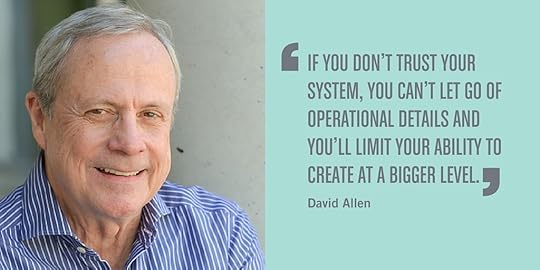David Allen's Blog, page 54
March 16, 2016
Where do your good ideas flow?
 I once coached a senior executive who, by anyone’s standards, could be considered one of the world’s most productive people. He’s known in lofty global corporate circles as a guy who “gets things done”—in particular, resolving volatile situations and closing complex, challenging, and highly rewarding deals.
I once coached a senior executive who, by anyone’s standards, could be considered one of the world’s most productive people. He’s known in lofty global corporate circles as a guy who “gets things done”—in particular, resolving volatile situations and closing complex, challenging, and highly rewarding deals.
On meeting him in his office, my first impression was that we might not have much to do in the way of workflow improvement. There was virtually no evidence of “stuff” around anywhere. Emails were less than a handful, voice mail was emptied daily, and no loose papers cluttered the desk. A meticulous note-taker, he maintained a rigorous journal of key thoughts and conversations, which was totally up to date, with no unprocessed notes lurking in previous pages. He was a model of “executive Teflon”—nothing was hung up around him. He made quick decisions and dispatched initiatives, projects, and tasks for implementation, with the leanest of support staff. Here was a master at professional self-management.
His presenting issue was not unique among high performers, except in its intensity. How, amidst a nonstop stream of mission-critical affairs he must attend to, 24/7, could he be sure that his focus was always on the right things, in the right way, at the right time? And have a life, to boot. He wanted my perspectives, but not because he was unproductive. Stretched to the max, he wanted to know if he was truly doing the best he could, and he wanted someone else’s informed eyes on his process.
I was curious to find out what would happen as we worked together (the value that occurs in our process is always unique to the person). I knew almost from the beginning that he would find our methods of virtual action reminder lists more efficient than his linear chronological tracking and bringing forward in daily hand-rewritten to-do lists. And I figured that a thorough review of his professional areas of responsibility and strategic plans against his Projects list would be healthy (for whom wouldn’t it?). But would that be worth the relatively big chunk of his extremely valuable time he was investing with me?
Suffice it to say that after three hours of capturing his still uncollected open loops, a day of organizing projects and actions into lists in a loose leaf binder we created, and some hard-nosed self-reflection at the higher horizons of his personal commitments and interests, he was delighted with the results. On following up with him some weeks later, I found his comments and feedback instructive and inspiring.
He said his efficiency has improved because his flow of ideas gets channeled much more directly into the appropriate parking places, almost as soon as he has them. There’s much less need to look back or rethink things. His peace of mind has also increased, knowing that absolutely everything has been captured along the way. (He thought he was good before, but now he has a new reference point.) He was most struck with the correlation between the clarity of mind this new system affords him, and two phenomenally valuable Big Ideas he’s had since after its implementation, which allowed him to solve a major dilemma and graduate significantly in his executive functioning. Our bottom-up approach to capturing and defining his work had actually facilitated a real advance in his own high-level strategic thinking, though we didn’t do any “high-level strategic thinking” as such. His biggest concern was the challenge to stick with the 100-percent capture behavior, primarily because the process of getting things out of his head and reviewing all his work from this more objective perspective kept catalyzing even more voluminous streams of valuable thinking!
Why share these details about this “poster child” for installing the Getting Things Done® best practices? I’ve written before about various aspects of the paradox we encounter all the time—those who take to our work the most are the ones who need it the least. But there was something special about this particular instance of that principle. I don’t think I’ve ever seen so many of the key aspects of our workflow best practices understood, tested, implemented, and put onto cruise control so rapidly, with a corresponding validation of the results in marked increases in stress-free productivity.
And, so many people who don’t feel they are quite “there” yet are looking for the next cool piece of gear, the next complex key and formula, the next life-hacking kind of technique that they haven’t tried yet to keep them on track—“If it’s new and looks hard, it’s probably what I haven’t done yet and what I need to do.” I’d probably have a more successful business model myself if I kept coming up with some “new version” of GTD. But that’s not the answer to stress-free productivity. As proven by my elegant client, the power is in the basics, completely and consistently applied. He demonstrated, indeed, the magic in the mundane, the sophistication in the simplicity, and the profundity in the practical.
I have to admit I have weird moments when I question my own stuff. Is it just too simple? Is it really necessary? Do people avoid implementing these behaviors as much as they do because there really is some better way to get things done? Then I get a chance at auspicious moments to taste it fresh again through the lens of the best and brightest, in the crucible of knowledge work at it most intense. I am (again) assured how well it works, how simple it remains, and humbled (again) by those high performing individuals I meet who jump in and really get Getting Things Done done.
If you don’t think you need any more GTD, maybe you need to think if you need to be playing a bigger or better game.
–David Allen
This essay appeared in Productive Living, our free educational newsletter, sent about once a month. Subscribe for free.
March 14, 2016
GTD and Self Leadership

Join David Allen in an intriguing conversation with Robyn Scott, a brilliant 30-something Brit with a fascinating background and palette of projects. As an author, social entrepreneur, and already a recognized leader in global change, she discusses how GTD has had an impact on her work, and explores with David a new and effective technique for motivating ourselves to actually take the next actions that we define.
Listen Now
Subscribe or Download
March 10, 2016
David Allen’s GTD Podcast Named in Top 10 by Inc.
We were thrilled to hear that our GTD podcast was named by Inc. as one of the top 10 productivity podcasts for 2016!

March 4, 2016
New Edition of Getting Things Done Audiobook
The 2015 edition of Getting Things Done is now available as an audiobook! Read by David Allen. See options for purchasing.

February 23, 2016
Trusting Your System
“If you don’t trust your system, you can’t let go of operational details and you’ll limit your ability to create at a bigger level.”
–David Allen
February 17, 2016
GTD at the Executive Level

Dr. Deb Smith-Hemphill, a long time practitioner and now Certified Trainer, GTD Connect member, and advocate of the GTD methodology, owns and manages her own successful management consulting business in California. In this witty and upbeat conversation, she chats with David about her professional path, her intersections with David and GTD, and gives lots of detail about her own streamlined system to get things done from an executive level.
Listen Now
Subscribe or Download
February 15, 2016
David Allen on Stalking the Wild Projects
 Perhaps the most profound result of creating a complete and accurately defined inventory of our projects is how it can propel us to do something positive and concrete about ephemeral and ambiguous situations that have our attention. We are all capable of taking dominion over every problem or challenging situation we encounter. But this doesn’t happen by itself.
Perhaps the most profound result of creating a complete and accurately defined inventory of our projects is how it can propel us to do something positive and concrete about ephemeral and ambiguous situations that have our attention. We are all capable of taking dominion over every problem or challenging situation we encounter. But this doesn’t happen by itself.
Nailing down the real outcome we’re committed to in those situations, when “the answer” is still not clear, takes awareness and focus. There is a subtlety and rigorous mental discipline required to create that “complete and accurately defined inventory of our projects.”
Defining a “project” as “anything you’re committed to complete that takes more than one step means that most people have between thirty and a hundred projects. Though many are somewhat obvious (hire a new assistant, set up the new computer, finish moving in), many aren’t. And as mundane as making a complete version of this kind of list may seem, it is key to masterful self-management.
It’s challenging enough to get someone to write down even the most evident projects (it takes some guts to face objectively all the commitments you’ve made with yourself). And even when you think you have your “total list” of projects, it seldom is. The ones that will elude you are the projects that you can’t even see yet as projects. They are the situations you implicitly have committed to change or improve, but haven’t gotten a grip on yet.
Often what will hang you up are uncomfortable, unfamiliar, or distracting circumstances you find yourself in, for which you haven’t yet gotten clear about how you’re going to relate to them. For example:
Potential professional relationships. “Acme Brick has approached us about a joint venture, but I’m not sure that’s something we want to do right now.” “Smedley Company has asked for a proposal, but I don’t know if we even want to do work for them.”
Sticky interpersonal situations. “My sister and her husband continue to avoid talking to me about the money they owe us.” “I don’t know if I can stand working for the person I have as my boss much longer.”
Personal development issues and opportunities. “I’m frustrated that I’m not further along in my career.” “I’m not sure if I should take time to learn more computer skills.”
Miscellaneous life and work situations. “I’m concerned about what Mom is going to do now about her house.” “We’re frustrated about the latest changes in the policies of our organization.” “I’ve got to do something about my energy.” “I don’t know how to deal with the troubles Jimmy is having in school this year.”
Then, because people don’t in the moment “have the answer” to the situation, they don’t take the opportunity to define a project of resolution, clarification, or research. If the above inner dialogs were part of your reality, your “Projects” list might begin to look something like this: “Research possible JV with Acme Brick,” “Clarify money issue with my sister,” “Evaluate career change opportunities,” “Resolve Mom’s living situation,” etc.
Then, and only then, can real next actions be determined which will be the key to your positive engagement with still vague and ambiguous things. Something that has been gnawing at your psyche melts away as you “Call Maria re: suggestions for elder care options” and “Email Arif re: meeting about Acme offer.” You don’t need the final solution to take away the pressure — you just need forward motion toward it.
Training yourself to identify all the things that are “yanking your chain” at any level of your awareness and define for each a positive result and an action to take to move toward it – that’s installing an extremely productive behavior, and a mark of significant maturity.
January 31, 2016
Keep everything in your head or out of your head
“Keep everything in your head or out of your head. In-between, you won’t trust either one.” –David Allen
January 16, 2016
January 13, 2016
Ways to use the Two-Minute Rule
So many people tell stories about how the Two-Minute Rule from GTD® has transformed their productivity. Here’s a fun way a music teacher is using it with his students. Read article

David Allen's Blog
- David Allen's profile
- 1484 followers






